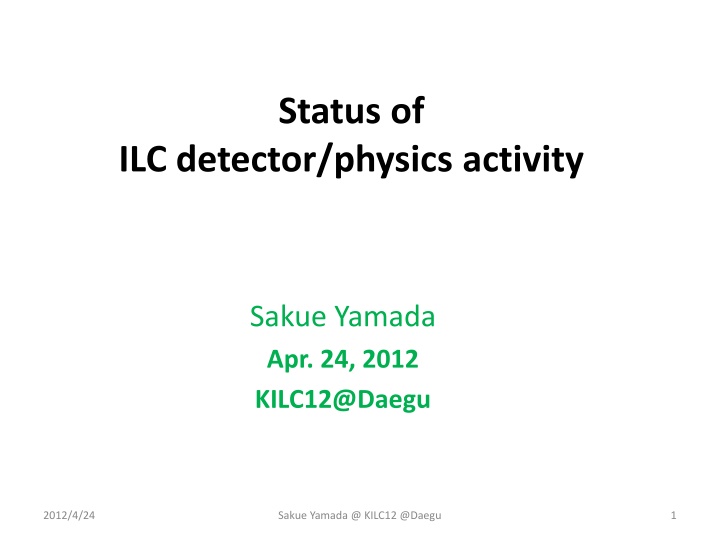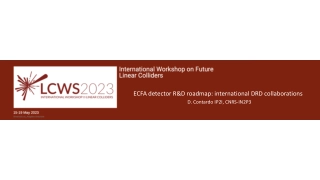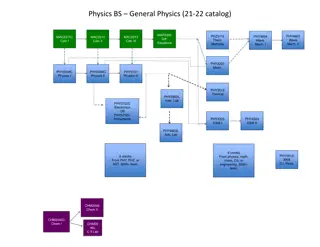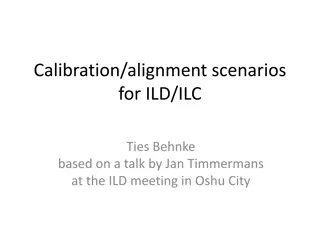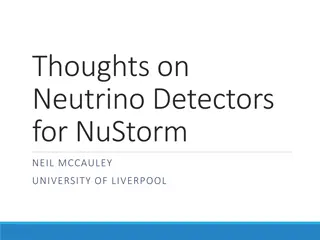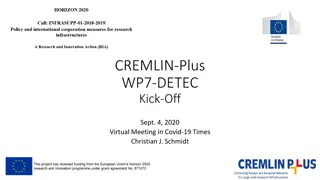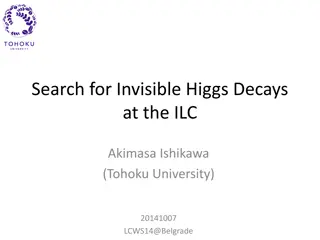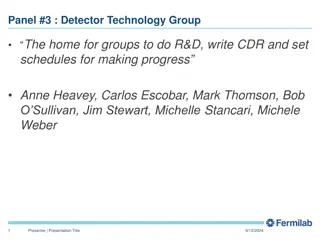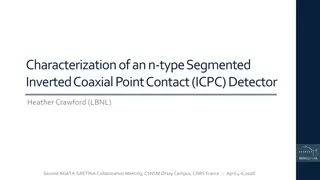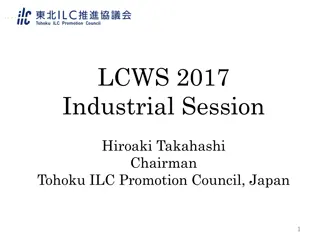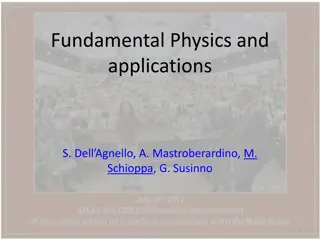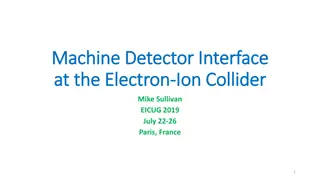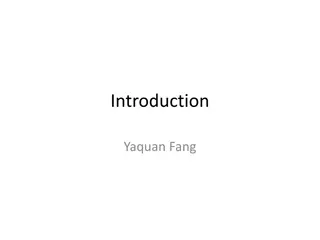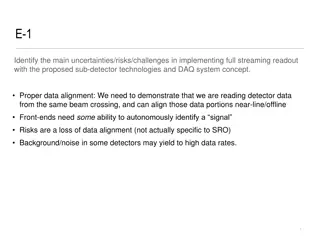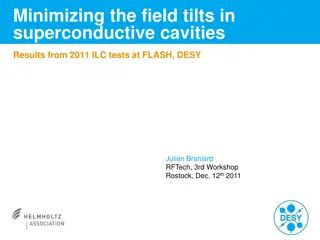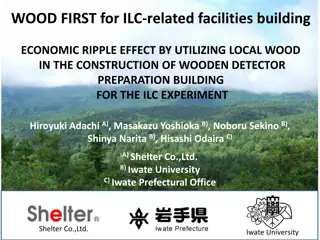Status of ILC detector/physics activity
This content provides an overview of the status of the ILC detector and ongoing physics activities led by Sakue Yamada. It includes details on preparation for the Detailed Baseline Design, interim report completion, lessons learned, and plans for the Detailed Baseline Design Report. The timeline of the LOI process, organization for DBD, and structure of the DBD volumes are also outlined. Overall, the content highlights the collaborative efforts and milestones towards advancing the ILC project.
Download Presentation

Please find below an Image/Link to download the presentation.
The content on the website is provided AS IS for your information and personal use only. It may not be sold, licensed, or shared on other websites without obtaining consent from the author.If you encounter any issues during the download, it is possible that the publisher has removed the file from their server.
You are allowed to download the files provided on this website for personal or commercial use, subject to the condition that they are used lawfully. All files are the property of their respective owners.
The content on the website is provided AS IS for your information and personal use only. It may not be sold, licensed, or shared on other websites without obtaining consent from the author.
E N D
Presentation Transcript
Status of ILC detector/physics activity Sakue Yamada Apr. 24, 2012 KILC12@Daegu 2012/4/24 Sakue Yamada @ KILC12 @Daegu 1
Topics Where we are Preparation for DBD IDAG monitoring of DBD Post-DBD activity 2012/4/24 Sakue Yamada @ KILC12 @Daegu 2
The time line of the LOI process Oct. 2007: Call for LOIs was made by ILCSC Jan. 2008: Detector management was formed Mar.2008: IDAG formed, 3 LOI groups known Mar.2009: 3 LOIs submitted Summer 09: IDAG recommendation for validation and ILCSC s approval Oct 2009: Work plan of the validated groups Mar:2009: IDAG began monitoring the progress End 2010: Interim report completed 2007 RDR 2008 2009 2010 2011 End 2012: Detailed Baseline Design Report 2012/4/24 Sakue Yamada @ KILC12 @Daegu DBD outline to be monitored 2012 KILC12 3
Interim Report completed Printing is still going. It is available on-line from the ILC web page. 2012/4/24 Sakue Yamada @ KILC12 @Daegu 4
Interim Report gave us good lessons. Many people contributed. Editing required big effort, which we depended on the communicators. Some items took time: high quality figures, checking of author list, the funding agencies to acknowledge, report numbers of supporting labs, etc. 2012/4/24 Sakue Yamada @ KILC12 @Daegu 5
Preparation for DBD Our 5 years efforts will be summarized in the Detailed Base Design Report. Together with GDE s TDR, DBD will be a part of the project proposal document when a consensus is reached that ILC is the LC to be built. The target date for completion is end of this year. 2012/4/24 Sakue Yamada @ KILC12 @Daegu 6
DBD will have 2 volumes Physics volume (80 pages) describes physics case for ILC Detector and simulation volume (350 pages) describes the feasibility of the detectors for solving the aimed physics questions. It has introductory chapter (50 pages) and detector chapters (150 pages for each). 2012/4/24 Sakue Yamada @ KILC12 @Daegu 7
Organization to make DBD Physics volume: a group of physicists convened by Michael Peskin. (The base is the Physics CTG but invites wider contribution. The group started early last year.) The group is studying the LHC results and waits for new ones with better statistics. Cf. Michael s talk) Detector and Simulation Volume: The two detector groups write their detector chapters. The introductory chapter will be written by the management and the common task groups. 2012/4/24 Sakue Yamada @ KILC12 @Daegu 8
General guidelines for the detector volume The detector chapters can be regarded as the advanced update of the LOI contents. Each group will write its detector concept, design, R&D of the components, simulation for benchmarks, cost estimation, and so on. The chapters need to be convincing for addressing the physics aims, and also attractive. The groups are free about where to put emphasis. The common items for the both detectors will be described in the introduction (to avoid duplication.) 2012/4/24 Sakue Yamada @ KILC12 @Daegu 9
DBD Format WG This group coordinates the format and contents among the introduction and detector chapters. Members: (ILD) T. Behnke, Y. Sugimoto (SiD) P. Burrows, M. Stanitzki (Management) J. Brau, J. Fuster, H. Yamamoto, S. Yamada This group agreed to work also as the editing team. The minutes of this WG can be accessed through our web page. (They must have been circulated in each group as well.) 2012/4/24 Sakue Yamada @ KILC12 @Daegu 10
Some of the discussions of the Format WG Due dates of the mile stones First draft: Sept. 21 (editing needs to be finished) Final draft: Dec. 21 LaTex is to be used for drafting. We are going to use the same template as TDR. Coordination with TDR will be made through P. Burrows. We collect the signatories again without copying from LOI. Where to place the author list is not decided yet. (E.g. RDR had all the authors together repeated in each volume.) 2012/4/24 Sakue Yamada @ KILC12 @Daegu 11
What will be covered in the introduction (organized by J. Fuster) Physics reach (This is a very brief summary of the physics volume). General requirements on detector performance at ILC Interfacing matters with the accelerator The necessity of two detectors and push-pull scheme Description of the physics/detector activity in this LOI period; mile stones, organization, IDAG, . Each common task group describes common items. E.g. Det. R&D, engineering tools, physics benchmarks and common simulation tools, . (The details will be posted as well.) 2012/4/24 Sakue Yamada @ KILC12 @Daegu 12
Further milestones toward the completion IDAG will monitor the contents: IDAG validated the LOIs of the groups and monitored the progress since then. Albuquerque (Sep,2009) Beijing (Mar.2010), Geneva (Oct.2010), Eugene (Mar.2011), Granada (Sept.2011) IDAG is familiar with the details from the very beginning. 2012/4/24 Sakue Yamada @ KILC12 @Daegu 13
IDAG monitoring in Daegu The outlines of the introductory chapter and the two detector chapters are in the hands of IDAG, and will be discussed. There will be interviews by IDAG of the two groups (SiD/ILD) (Tuesday), of Physics CTG convener(s) (Tuesday), and of the software CTG members (Wednesday). We expect comments on the material for improvement. Drafting should be completed in 5 months from now. The drafts after the first round edit is to be given to IDAG by end September. 2012/4/24 Sakue Yamada @ KILC12 @Daegu 14
Monitoring of the drafts by IDAG During the LCWS in Arlington, Texas, in October. IDAG gives comments on the first draft. After this monitoring, there are about 2 months to complete DBD. PAC will meet on December 15/16 at KEK. We wish to submit almost final version of DBD to PAC by end November. (PAC may also give us comments from its point of view.) 2012/4/24 Sakue Yamada @ KILC12 @Daegu 15
Executive Summary of TDR & DBD There will be an executive summary of all volumes of TDR and DBD. We are going to participate in drafting this. The authors, who need to be familiar with the DBD contents, will be assigned. 2012/4/24 Sakue Yamada @ KILC12 @Daegu 16
After completion of DBD We submit DBD to ILCSC in early 2013 to be our final report. There may be some polishing for publication. GDE is planning a launching event of TDR/DBD in Summer 2013. We will certainly participate in the event. Details are to be worked out. The event may be organized in each region, nearly simultaneously or in series. 2012/4/24 Sakue Yamada @ KILC12 @Daegu 17
We are going to concentrate our efforts on DBD now so that, together with TDR, it make a good proposal for ILC, hoping new physics by LHC push ILC forward. 2012/4/24 Sakue Yamada @ KILC12 @Daegu 18
Summary of key dates for DBD By End September: Full drafts to be given to IDAG IDAG comments during LCWS12, in Arlington. By End November: Polished draft (semi-final) given to PAC PAC comments in mid December. December 21: the final DBD completed 2012/4/24 Sakue Yamada @ KILC12 @Daegu 19
Consideration about the post-DBD period Various moves regarding post 2012 activity. Studies of LC physics based on the coming LHC result Consideration by ILCSC of the new LC- promoting organization after 2012 Our own plan regarding detector R&D, design and simulation 2012/4/24 Sakue Yamada @ KILC12 @Daegu 20
Post DBD (LC Physics study) Studies of LC physics for various cases will be important. Various studies are organized. It is linked with the choice of the energy. We look very much forward to news from LHC and its through investigation by the physics group for DBD. It may be too early to conclude during this WS. But we can exchange views on possible cases in order to enrich our understanding. 2012/4/24 Sakue Yamada @ KILC12 @Daegu 21
Post DBD- (LC Physics Study) We should recollect that already 20 years ago, when there was less clue for new physics, people thought about building an e+e- Linear Collider. With more solid knowledge for new physics, we are now in a better position to form a realistic strategy. 2012/4/24 Sakue Yamada @ KILC12 @Daegu 22
Post DBD- (Post 2012 scheme) ILCSC is discussing the new organization for the post 2012 LC promotion. This was shown in Granada by the chair, J. Bagger. 2012/4/24 Sakue Yamada @ KILC12 @Daegu 23
Post DBD- (Post 2012 scheme) The physics/detector box contains both ILC and CLIC. How to organize this is a question to be solved. Some preparatory meetings started among the detector/physics community or between CLIC and ILC people but proceeding slowly. There are many aspects to be considered. There is no clear platform to study such issues. Nevertheless, we need to think and find a good solution. It may take some time. 2012/4/24 Sakue Yamada @ KILC12 @Daegu 24
Post DBD (Our own plan) It is important for us to plan ourselves what and how we want to continue after DBD. Are the concept groups to continue ? What can be our goal for the post DBD period? 2012/4/24 Sakue Yamada @ KILC12 @Daegu 25
Post DBD (Our own plan) When ILC is chosen clearly for the next LC, these questions can relatively easily be answered. e.g. We want to work hard for its realization, finish remaining R&D and proceed for engineering design toward construction. The concepts will continue these efforts. (I hope more mixture among regions occur.) Our life may not be easy but we will have a clear goal and plan to accomplish it. 2012/4/24 Sakue Yamada @ KILC12 @Daegu 26
Post DBD (Our own plan) If it takes time to decide which LC to choose, we may go on with R&D and physics studies. It will be harder to set a clear objective. In this case also the concept may remain. But effort will be less focused. This can result in a danger that young people leave the LC community. 2012/4/24 Sakue Yamada @ KILC12 @Daegu 27
Post DBD (Our own plan) The physics study based on the LHC result will be very important to choose our way. We wish to be lucky that LHC brings a clear information for ILC about SM Higgs, either confirmation or rejection, or about something NEW. 2012/4/24 Sakue Yamada @ KILC12 @Daegu 28
